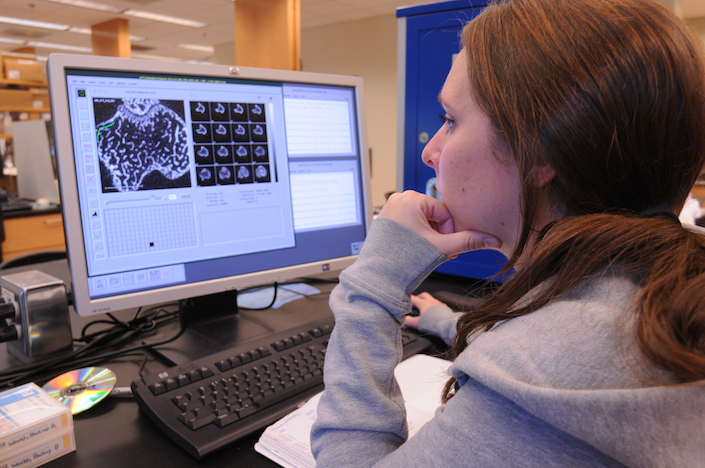Musculoskeletal Alterations Team

Reducing fracture risk in cancer patients: Clemson University graduate student Stephanie Riffle analyzes data from spongy bone collected for an NSBRI project studying space radiation-induced bone loss and determining which treatments can be used to reduce that loss and lower the risk of fractures.
 When working in space, astronauts lose bone and muscle from their legs, hips and lower backs due to reduced load-bearing. To put the bone loss in perspective, postmenopausal women who are untreated for bone loss can lose 1-1.5 percent of bone mass in the hip in one year while an astronaut in microgravity can lose the same amount of hip bone mass in a single month. Loss of musculoskeletal tissue mass and function can cause multiple problems for the crew during long-duration space missions, including reduction in physical performance, increased risk of fall-related injuries and accidents, and potentially, bone fractures.
When working in space, astronauts lose bone and muscle from their legs, hips and lower backs due to reduced load-bearing. To put the bone loss in perspective, postmenopausal women who are untreated for bone loss can lose 1-1.5 percent of bone mass in the hip in one year while an astronaut in microgravity can lose the same amount of hip bone mass in a single month. Loss of musculoskeletal tissue mass and function can cause multiple problems for the crew during long-duration space missions, including reduction in physical performance, increased risk of fall-related injuries and accidents, and potentially, bone fractures.
The Musculoskeletal Alterations Team is studying the mechanisms involved in bone and muscle loss and whether reduced gravity increases the risk of bone breaks and impairs fracture healing. The Team is also researching radiation-induced bone loss. In addition to identifying ways to enhance the benefits of exercise during spaceflight for maintaining muscle and bone function, the Team is also investigating methods to prevent or reduce the loss through nutritional and pharmaceutical interventions to complement exercise.
The Team’s efforts will also have benefits on Earth for people with bone disorders, cancer patients and people who are immobilized due to injury or surgery.
Leaders
Team Leader:
Henry J. Donahue, Ph.D.
Virginia Commonwealth University
Associate Team Leader:
Charles H. Lang, Ph.D.
Pennsylvania State University
Impact in Space
The Musculoskeletal Alterations Team is developing countermeasures to the negative effects of spaceflight on muscles and bones. Current in-flight exercise regimens, dietary and vitamin supplements, and pre-flight conditioning have not prevented bone loss during long-duration flights such as those on Russia’s Mir Space Station and the International Space Station.
Also, long-duration exposure to microgravity produces functional deficits in skeletal muscle. These include atrophy in the muscles of the lower extremities and losses in strength and power, a shift in appearance and contractile quality of muscle, and deficits in motor control and movement. All of these changes could lead to injury.
The Team’s anticipated deliverables for spaceflight include:
- Ground-based simulation of on-orbit exercise devices;
- Balance and coordination training combined with resistance and aerobic exercise;
- Specific exercise prescriptions tailored to individual astronauts;
- Pharmacological therapies for bone loss;
- Compounds and pharmacologic agents to protect against muscle weakness and fatigue; and
- Designing improved exercise devices.
Impact on Earth
Maintaining bone health during spaceflight is a major goal for researchers. The efforts of the Musculoskeletal Alterations Team will have benefits for people on Earth with bone disorders or are incompacitated due to injury or illness and for people participating in exercise and training programs. The benefits of the Team’s research for Earth are:
- Practical countermeasures to lessen atrophy and weakness would benefit individuals immobilized by injury or surgery;
- Methods to prevent and reduce bone loss can be used for treatment of osteoporosis and for other patients such as paraplegics, who experience increased bone loss;
- Improved exercise techniques to maximize maintenance of bone mass for people suffering from bone disorders;
- A countermeasure to inhibit fatigue would benefit a broad range of people whose work requires physical exertion ranging from military personnel to firefighters, police officers and construction workers;
- Insight into practical ways to improve muscle mass and lean body mass in both young and old individuals, and application to sports training as a means to help aging individuals maintain strength in their limb muscles, thus reducing accidents and injury;
- Novel therapies to prevent or treat the marked wasting of muscle seen in bed-ridden patients and ones with systemic disease (cardiac failure, cancer, sepsis, AIDS);
- Development of a personal monitoring system could help individuals manage their bone health based on personal exercise goals and real-time feedback; and
- Methods of improving the bone health of cancer patients undergoing radiation treatment.





